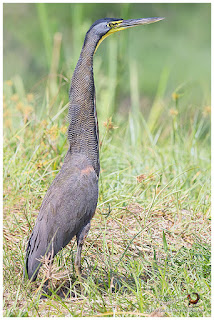On the third day we decided to stay in the lowlands of the western Pacific side, the main intention was to try to find some wading birds that could be migrating from northern latitudes due to the coming winter. Specifically Roseate Spoonbills, Great Blue Herons, and Tricolored Herons that have been seen around previously. Unfortunately, things in wildlife photography are not always as expected, the fields had not as much water as it used to be, and the remaining flooded areas did not have much birds as expected.
We were able to see Black-necked Stilts and Black-bellied Whistling-Ducks, Southern Lapwings Ringed Kingfisher, Osprey, Roadside hawks, Cattle Egret and usual waders like Great Egrets, Little Blue Heron, Green Herons, Great Blue Heron (very far away), Wood Storks.
Sun was inclement and temperatures were high, finally our efforts along half the day provided the pictures below. By approximately 1:00 pm we decided to return to David city, an stay there resting and advance the photo editing process; the following morning we returned to Panama city, finishing the tour.
Bare-throated Tiger-Heron (Trigisoma mexicanum), this was the first time we caught it with the neck extended this way, initially it tried to deceive us simulating it was part of the tall thicket, but eventually it noticed I was not buying it, so it started its retreat and in that moment I was able to get this shot of it displaying its long neck out of the thicket.
Lesser Yellow-headed Vulture (Cathartes burrovianus)
This Northern Jacana (Jacana spinosa) may felt threatened by our presence and decided to show its spurs. Now, you know why the spiny name.
This other jacana didn't bothered by the presence of the car and we were able to make the shot from the inside.
Tropical Kingbirds (Tyrannus melancholicus) were common in fence wires along farmland, as well as other Tyrants like Kiskadees, also Fork-tailed Flycatchers were observed.
At one of the roads I found a large family of caracacaras, mostly immatures, gathered at the same tree and fence posts below the tree. I took the opportunity to get pictures of these very common species that were missing good pictures in our portafolio. There were at least four (4) Yellow-headed and three (3) Crested.
Disregarding the fact that caracaras are
birds of prey in the family
Falconidae, they are not fast-flying aerial hunters, but are rather
sluggish and often
scavengers. Both species below tend to eat carrion and sometimes small live animals. The live prey they do catch is usually immobile, injured, incapacitated or young. They are often seen
on ground, especially
near highways, where it forages for
roadkill, and both are found in
open areas like the farmlands I was driving thru.

Crested caracara or Northern Crested Caracara (Caracara cheriway) was formerly considered
conspecific with the Southern Caracara (C. plancus). It is a resident in Cuba, northern South America (south to northern Peru and northern Amazonian Brazil) and most of Central America and Mexico, just reaching the southernmost parts of the United States, including Florida, where it is resident but listed as threatened. It can also be found (nesting) in the Southern Caribbean (e.g. Curaçao and Bonaire). This is a bird of
open and semi-open areas, and in Panama it's
very common on Pacific slope lowlands eastward to eastern Panamá Province and rare on Caribbean slope in the Canal Area.
Immature birds are browner, have a buff neck and throat, a pale breast streaked/mottled with brown, greyish-white legs and greyish or dull pinkish-purple facial skin and cere.
The Yellow-Headed Caracara (Milvago chimachima) is found in tropical and subtropical South America and the southern portion of Central America. This is a bird of savanna, swamps and forest edges. Resident from Costa Rica (expanding to Nicaragua) south through Trinidad and Tobago to northern Argentina. In southern South America, it is replaced by a close relative, the Chimango Caracara. In Panama it's very common on Pacific slope open areas eastward to eastern Panamá Province, and less common on Caribbean slope in the Canal Area.
The adult has a buff head, with a black streak behind the eye, and buff underparts, the upper plumage is brown with distinctive pale patches on the flight feathers of the wings, and the tail is barred cream and brown. The head and underparts of immature birds have dense brown mottling.













Comments
Post a Comment